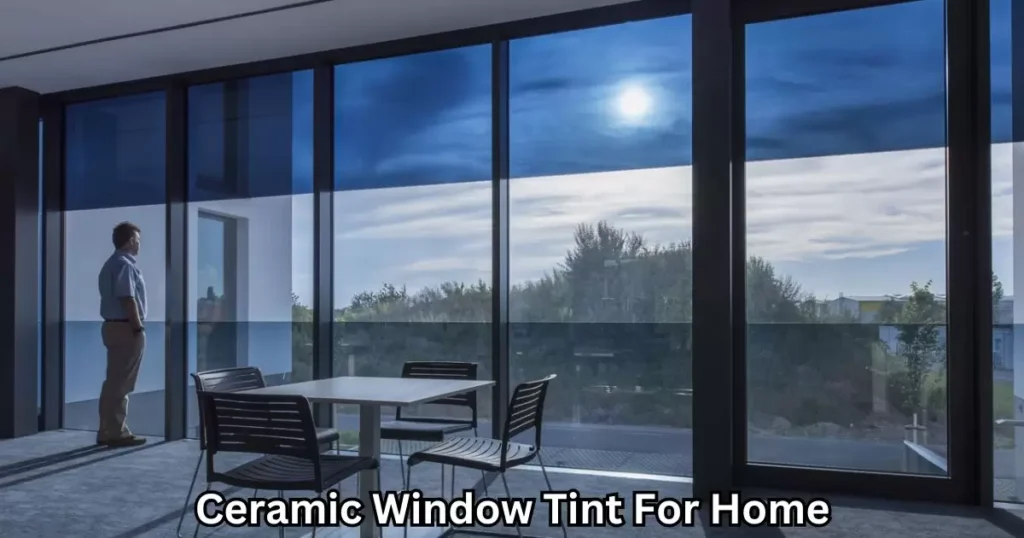Ceramic window tint is a type of window film made up of tiny ceramic particles embedded in the tint. It is designed to block heat and UV rays from entering homes through windows. Ceramic tint allows a certain percentage of visible light to pass through while reflecting infrared light. This helps keep interiors cooler and protects furnishings from sun damage.
Ceramic Window Tint For Home use is becoming increasingly popular for homeowners aiming to cut cooling costs and improve comfort. This innovative window treatment technology lets in natural light without letting in lots of heat and damaging UV rays. Homeowners enjoy the benefits of daylighting without sacrificing efficiency or interior design.
Ceramic window films are installed directly onto existing glass windows, providing an economical retrofit option. They work with dual pane, single pane, and even some garden windows. The ceramic particles make the tint more effective at blocking solar radiation than traditional dyed films. Ceramic films also resist scratching and oxidation better. Overall “Ceramic Window Tint For Home” helps household energy efficiency and sustainability.
Benefits Of Ceramic Car Tint For Home Windows

Ceramic car tint provides several benefits when installed on home windows. Key advantages include blocking up to 99% of UV rays to protect furnishings and family from fading and skin damage, leading to a cooler interior in summer by rejecting heat, reducing glare that strains eyes, and enhancing privacy without sacrificing natural light.
It also makes windows more durable and resistant to damage while giving them an attractive, upscale aesthetic. For vehicles, individuals often seek one way car window tint to enhance privacy and reduce glare while maintaining a stylish appearance.
Comparison To Other Films
Unlike standard tints containing metal and dye, ceramic nanoparticles allow exceptional heat rejection and longevity without signal interference to phones, TVs, etc. It excels in durability over dyed films prone to fading and offers far more heat resistance than basic options. The advanced technology makes ceramic well worth the higher price for unparalleled performance.
Choosing Ceramic Tint
When selecting ceramic tint, consider percentage of light transmittance, special coatings like scratch resistance, professional local installers with experience, and checking regional legal limits on darkness. Getting quotes from at least 3 tint shops on recommended products for your climate is wise. Prioritize quality over cost.
Diy Installation Tips
While professional installation is best for flawless results, DIY is possible with careful prep and patience. Clean windows thoroughly, work in a dust-free area, measure precisely, use a plastic card for smooth application, spray soapy water solution to reposition, and take time pressing out air bubbles. Watch tutorials before attempting.
Affordable Options
Quality ceramic tint starts around $100-150 for a basic kit sized for one window pane. Search sites like Home Depot for sales on brands like Llumar and Vista. For whole house coverage, the most affordable route is getting quotes from local professional tinters advertising home packages around $400-600 rather than doing it yourself.
Advantages Of Using Ceramic Car Tint On Home Windows
Ceramic car tint can provide excellent UV ray protection for home windows. According to the search results, ceramic films can block up to 99% of UV rays from entering a home. This helps protect furnishings and decor from fading and damage. It also reduces skin damage and health risks from excessive UV exposure inside the home.
Does Ceramic Tint Block Uv Rays Coming Into My House
The search results state that ceramic window tints are extremely effective at blocking UV rays, with up to 99% UV protection. This is far higher than plain glass or even standard dyed films. The ceramic particles in the tint reflect and absorb UV radiation before it can enter the home. This provides exceptional UV blocking capabilities.
Ceramic Home Window Tint Help Reduce My Energy Bills
Yes, ceramic tints can help reduce energy bills. By blocking up to 99% of solar heat from entering a home, ceramic films reduce the heat load on air conditioners. This allows AC units to run less often, saving electricity. The search results indicate that the energy savings from window tints can be substantial over time.
Safety And Security Benefits Does Ceramic Tint Provide For A Home
Ceramic tints improve home safety and security in a few key ways. First, they prevent glass shards from scattering if a window breaks. The film helps hold the glass in place. Second, darker tint shades obscure views into a home, preventing people from peering inside. This deters burglars casing properties to rob.
More Privacy Does Ceramic Window Film Allow In My Home
The level of added privacy depends on the shade selected. At the darkest end, ceramic tints can block 70-75% of visible light. This prevents people from seeing inside. Lighter shades still provide some privacy improvement by obscuring views. Overall, ceramic window films provide vastly increased privacy compared to plain, untinted glass.
Comparing Ceramic To Dyed, Metallized, And Other Films
Ceramic window films are made from metal oxide particles fused into the film for superior heat rejection compared to traditional dyed films. They block more infrared light while maintaining visibility. Ceramic films also do not contain dyes that can fade or metals that can interfere with signals.
Why Is Ceramic Superior To Dyed Or Metallized Tints For Home Use?
For homes, ceramic window tints are preferred because they provide better heat rejection to keep interiors cooler, maintain clarity rather than causing dark tinting, and resist fading or discoloration over time. Ceramic films also do not interfere with radio frequency signals from devices in the home.
Costs Of Ceramic Vs. Other Window Films Compare For Homes
Though more expensive initially, ceramic window tints have a longer lifespan of up to 15 years compared to 5-7 years for dyed films. This evens out the costs over time and reduces the frequency of reapplication. The superior performance and durability make ceramic films a smart investment for homes.
Major Differences In Durability And Lifespan
Ceramic window films are extremely durable and fade-resistant, lasting up to 15 years with warranty coverage compared to 5-7 years max for dyed films. Ceramic films maintain optical clarity and performance longer with less bubbling, cracking, or discoloration over decades of UV exposure. This longer lifespan saves money over time.
Key Considerations For Choosing Ceramic Tint
When selecting a ceramic window tint for your home, key factors to consider include the level of heat rejection, glare reduction, and UV protection you want, as darker tints block more light and heat. Also consider visibility needs, especially for any driving-related windows, and check your state and local laws on legal limits for home window tint darkness and reflection. Finally, weigh the cost vs performance benefits of professional installation vs DIY application.
How Dark Or Reflective Should I Go With Ceramic Tinting At Home?
The darkness and reflectivity of ceramic tint that is optimal for your home depends on your climate, window exposure to direct sunlight, privacy preferences, and local laws. For hot, sunny areas, darker tints from 5-15% VLT can maximize heat rejection and UV protection, but check regulations first. Moderate 20-35% VLT tints still filter significant glare and heat while allowing more visibility.
Different Window Types Impact The Performance Of Ceramic Tint
Performance of ceramic tint can vary by window type. For example, tint adheres better to flat, smooth surfaces like glass over textured surfaces, and plastic or acrylic windows can become too hot under darker tints. Consult your installer on the best pairings of window materials and ceramic films.
Appearance Concerns Might I Need To Factor In For My Home
Key aesthetic factors for home ceramic tint include coloration from the film itself and potential visibility of air bubbles. Quality ceramic films resist fading, discoloration and offer clarity, but darker tints can still have a color cast. Professional installation optimizes smooth adherence to avoid trapped air pockets.
Should I Get A Professional Installation Or Diy For Home Ceramic Film?
Professional installation is highly recommended for home ceramic tint to ensure proper film cutting, window preparation, and application technique. This maximizes durability, appearance, and performance over the long term. DIY is cheaper but much harder to apply correctly, especially on larger or non-glass windows.
Diy Installation Tips For Home Ceramic Tint
To install ceramic window tint at home, you’ll need a spray bottle, lint-free cloths, a utility knife, a squeegee, tape measure, and the ceramic film itself. Making precise measurements and cuts prevents issues like bubbles or creases. Add an extra inch when cutting to give yourself a margin of error.
Carefully apply the adhesive side of the tint to the interior window glass. Use the spray bottle and squeegee to remove bubbles and ensure smooth, tight adhesion. Take your time and don’t rush the installation.
Tools And Supplies Do I Need For A Diy Home Window Ceramic Tint Job
| Tool | Use |
| Squeegee | To smooth film. Remove bubbles. |
| Utility knife | Cut film to size. |
| Spray bottle | Spray slip solution. |
| Slip solution | Let film slide into place. |
| Lint-free towels | Clean windows. Dry windows. |
| Tape | Hold film while installing. |
| Razor blade | Remove stuck items. |
| Hard card | Push film into corners. |
| Heat gun | Heat film if needed. |
The key tools are a squeegee to apply the film, a utility knife to cut it to size, slip solution spray to allow positioning, and lint free towels to prep and dry the window surface. Other helpful tools include tape, a razor blade, a hard card, and a heat gun. Having the right supplies makes DIY ceramic tint easier.
What Tricks Make Accurately Measuring And Cutting Ceramic Film Easier?
When measuring windows, add an extra inch on all sides to give yourself a margin of error. Measure twice to ensure accuracy before cutting. Use a sharp utility knife and straightedge as guides to cut smooth edges. Work slowly and carefully when cutting to avoid tearing the film.
How Can I Get A Tight Adhesion And Smooth Application At Home?
Preparing the window surface and ceramic film with a light water spray allows you to position the tint while sliding it into place. Use a plastic squeegee to remove water and air bubbles, pressing firmly to adhere the film tightly from the center outward. Take your time and work in sections to apply the tint smoothly.
Mistakes Should I Avoid When Installing Ceramic Tint On My House Windows
Rushing the job can lead to bubbles, creases, and other imperfections. Allow sufficient time and don’t skip any preparation steps. Also avoid touching the adhesive side of the film since dirt and oil from skin can interfere with proper bonding to the glass. Carefully follow the manufacturer’s instructions for best results.
Finding The Most Affordable Ceramic Film Products
The best places online to find discounted ceramic window tints for homes are sites like TintDepot, Bargain Bin at Scorpion Protective Coatings, and the clearance sections of specialty retailers like FlexFilmStore.
These sites offer pre-cut films, discontinued items, and overstock at reduced prices. Subscribing to retailer newsletters can also alert you to periodic sales events and specials on ceramic home window films.
Best Places Online To Buy Discounted Ceramic Tint For Homes
I would recommend checking the bargain bins or clearance sections of major window film retailers like TintDepot, Scorpion Protective Coatings, and FlexFilmStore. These sites periodically discount or sell pre-cut remnants of ceramic film products for homes at reduced prices.
Certain Brands Known For Cheaper Prices On Home Window Ceramic Films
There are not brands specifically known for being cheaper. However, watching for sales, specials, remnants, and discontinued ceramic film lines from major brands like Llumar, SunTek, FormulaOne, and Johnson Window Films can yield discounts on quality home window ceramic tints.
What Times Of Year Or Sales Events Can Score Me Savings On Ceramic Tint?
Retailers tend to offer periodic sales, clearance events, or holiday sales that can include special pricing on ceramic films. Times like Back to School sales, Black Friday, Cyber Monday, inventory clearance sales, etc. can be good opportunities to find ceramic tint discounts. Subscribing to retailer newsletters can alert you to these savings events.
Is Getting Ceramic Tint Professionally Installed Worth The Extra Investment For My Home?
Yes, professional installation is highly recommended to ensure proper adhesion, no bubbles/creases, and to get the full heat rejection benefits. Improper DIY installation can lead to peeling, bubbling, visibility issues etc.
The extra cost is worth it for the expertise, warranty protections, and quality end results.
Frequently Asked Question
What Are The Benefits Of Home Ceramic Tint?
Ceramic home window tints reject heat, block UV rays, reduce glare, and lower energy bills while allowing natural light in.
Does Ceramic Film Work On All Window Types?
Ceramic tint adheres best to flat, smooth glass surfaces so performance varies on textured or plastic window materials.
Can I Install Ceramic Tint Myself In My House?
DIY ceramic tint application is possible but tricky, so professional installation is highly recommended for proper film cutting, prep, and technique.
How Dark Can I Legally Go With Ceramic Home Window Tint?
The legal limits on darkness levels of ceramic home window tint depend on local regulations, but moderate 20-35% VLT films still provide protection.
Is Ceramic Better Than Basic Dyed Window Film?
Yes, ceramic tint contains nano-ceramic particles that more effectively block heat and UV rays compared to traditional dyed films.
Conclusion
Ceramic window tint blocks heat and UV rays. It helps lower energy bills for cooling. This type of tint also protects furniture from sun damage. DIY installation is possible but can be tricky. Hiring a professional may cost more but saves time and frustration.
Ceramic tint is a great option for home windows. It keeps interiors cooler and protects belongings. While DIY application is possible with patience, professional installation typically gives the best results.
For those wanting privacy, security or energy savings, ceramic window films are an effective solution. Evaluate your skill level and budget to decide whether to DIY or hire an expert tint installer.



